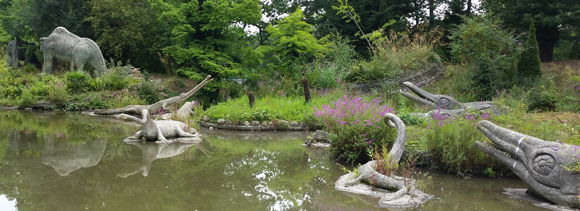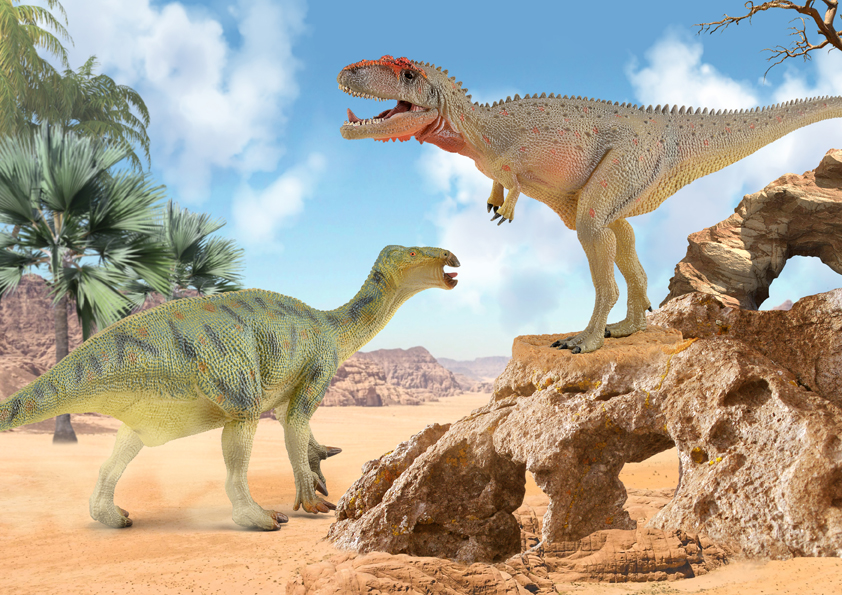Crystal Palace Statues Helping with Outdoor Learning
Recently, Everything Dinosaur has been providing advice on how best to utilise the outdoor resources at the famous Crystal Palace Park in south London. Schools have been invited to make the most of this area, with its historic “dinosaur statues”. Outdoor learning is being encouraged and the park with its hard and soft landscaping as well as its iconic prehistoric animal figures makes a fantastic open space for creative activities linked to the English national curriculum. Everything Dinosaur is delighted to support the Crystal Palace Dinosaurs.
One of the Dinosaur Statues on Display at the Park (Megalosaurus)

Picture credit: Everything Dinosaur
Prehistoric Animal Figures Not Just Dinosaurs
In reality, dinosaurs make up only a small proportion of the more than thirty statues on display. The figures created by Benjamin Waterhouse Hawkins with scientific input from the soon to be knighted Sir Richard Owen, who went onto to help found the London Natural History Museum, include marine reptiles, crocodilians, turtles and extinct mammals. They were erected in the middle of the 19th century (circa 1854) and they represent the first attempt to create life-size, dinosaur figures. However, our view of the Dinosauria has evolved somewhat since the 1850s and the dinosaurs, depicted as four-footed, tail-dragging scaly lizards, is wildly inaccurate by today’s standards.
Marine Reptiles Feature at Crystal Palace – Statues Inspired by the Discoveries Made by Mary Anning

Picture credit: Everything Dinosaur
Crystal Palace Dinosaurs – Grade 1 Historic Monuments
All the figures are listed on Historic England’s “National Heritage List for England” as Grade 1 monuments. This listing recognises the historic importance of these statues and a lot has been done to help preserve the dinosaurs and other figures as part of our country’s scientific and historical heritage.
In our advisory work, team members have suggested ways in which our changing views about the Dinosauria can be incorporated into the teaching programme. The dinosaurs represented by the figures, the first three genera to be incorporated within the order Dinosauria, Megalosaurus, Hylaeosaurus and Iguanodon, show how our interpretation of the fossil record has changed over the last 170 years or so. The statues provide a three-dimensional testament to how scientific ideas evolve and change in the light of new evidence.
The Iguanodon (Foreground) – A Modern Interpretation of an Iguanodontid

The spike associated with fossils of Iguanodon is now known to have been part of the hand (a thumb spike), whereas, in the 1854 model, the lizard-like Iguanodon statue has the spike incorrectly placed on the bridge of the snout.
One of the Iguanodon Figures on Display at Crystal Palace Park

Picture credit: Everything Dinosaur
Team members at Everything Dinosaur wish all those involved in the schools outreach programme at the Park every success.
Visit the Everything Dinosaur website: Everything Dinosaur.
It is always a pleasure to visit the Crystal Palace Dinosaurs.
To view scientifically accurate dinosaur models, including a 1:40 scale replica of an Iguanodon (I. bernissartensis): CollectA Deluxe Prehistoric Life Models and Figures






[…] The giant models lurk on their islands in total disregard to any accuracy or scientific progress, although the history of their creation and position in the scientific discourse is incredible. The trees and shrubs they hide behind are of our era, but that doesn’t matter, not even that none of these creatures would be seen in such proximity millions of years ago. Not in time or place. They are a world of their own, a snapshot in time, of their time and of a Victorian time. Created as spectacle and education, they still do both but now in a different context it is a different spectacle, a different education. […]